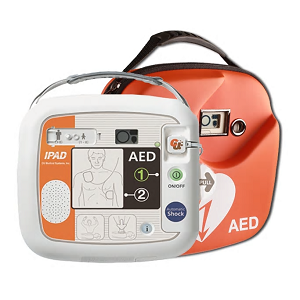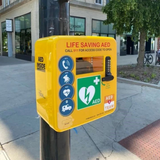What is a defibrillator?
One of the most devastating parts about sudden cardiac arrest is that it can happen to anyone, anywhere and requires instant treatment. The cause is due to the sufferer’s normal heartbeat being interrupted and sent into a state of fibrillation, which is where the heart no longer pumps, but quivers. This leads to the brain and vital organs not receiving the required amount of oxygenated blood, the brain shutting down and the victim stopping breathing.
The only treatment for sudden cardiac arrest is defibrillation and to act straight away, as every minute counts and treatment within 5 minutes leads to higher survival rates. Defibrillators are a quick and easy way to provided defibrillation, but what is a defibrillator and how do they work?
What Are Defibrillators?
When a sudden cardiac arrest strikes, defibrillators can help save lives. They are designed to provide the high-energy electric shock that the heart needs, in order for it to be restored to its natural rhythm. Or in other words, defibrillators stop fibrillation.
When someone is suffering from cardiac arrest, acting quickly is essential and technology advancement has allowed AED defibrillators to be a first response. They can be utilised before the emergency services arrive on scene, providing quick and efficient treatment. Being a lightweight, portable, battery operated and simple to use also makes them perfect for public use and to be placed in public areas.
If someone is suffering from a cardiac arrest, instructions from the machine talk the user through what to do. Once attached to the victim an AED will automatically analyse their heart rhythm and deliver the shock that is needed to help. The process is simple and completely safe as defibrillators will not shock patients who do not require a shock.
One of the main attributes that make defibrillators a key life-saving machine is that they can be used by virtually anyone. You don’t need to be a medical professional or have any training. The beauty is that the machine gives both visual and vocal instructions that can be easily followed and does all the work for the user, no stamina, strength or previous knowledge is needed.
In recent years there has been a focus on providing greater knowledge regarding sudden cardiac arrest and AED's, which is why they can be found in a number of public places. These include business; shopping centres, homes and other areas with a high public footfall.
Our Automated External Defibrillators
If you are looking for a life-saving AED, then you need to choose Risk Assessment Products. We are specialists in providing top of the range healthcare and safety products to clients throughout all walks of business.
We have an extensive range of defibrillators and accessories, which include easy portable machines, defibrillator cabinets, cases and backpacks. As well as catering to all of your AED needs that help diagnose signs of life-threatening cardiac rhythms in a patient, we also advertise all of our prices online.
Recent Posts
-
What is CPR?
Knowing the basics of first aid and how to deliver CPR (cardiopulmonary resuscitation) can make the …17th Nov 2024 -
What is a sudden cardiac arrest (SCA)?
Sudden Cardiac Arrest (SCA) is a critical medical emergency where the heart abruptly ceases to funct …17th Nov 2024 -
Empowering Communities: The Lifesaving Impact of CPR on Restart a Heart Day
Every year, on and around October 16th, an important event takes place - Restart a Heart Day. This a …16th Oct 2023




